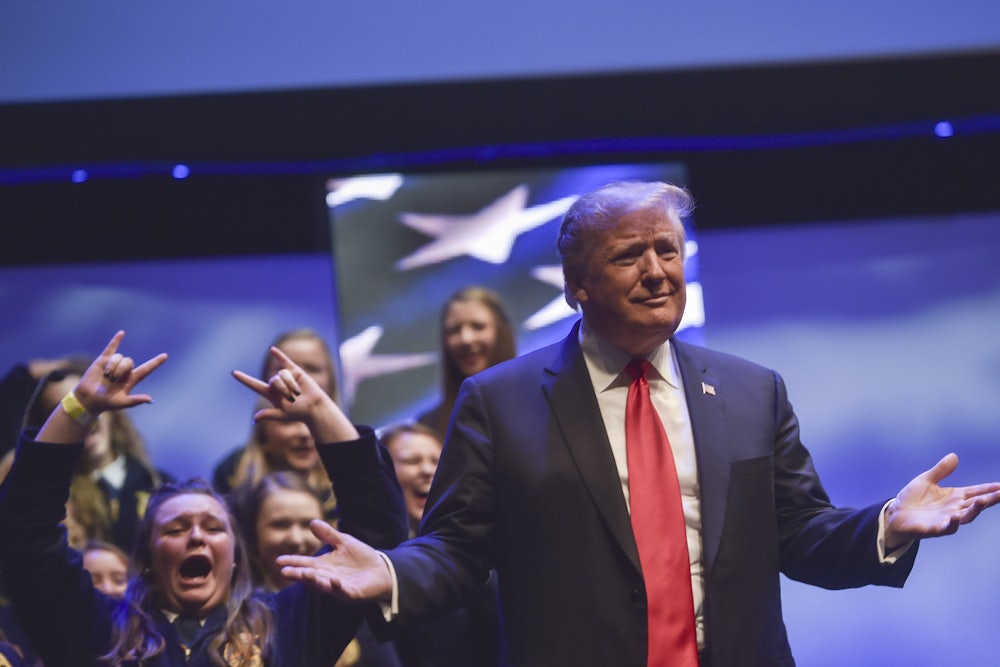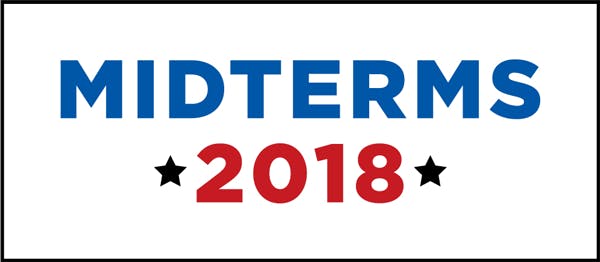President Donald Trump announced on Monday he would send 5,200 military troops to the southern border as a means of discouraging the 3,500-person migrant caravan inching its way toward the U.S. from Central America. It’s a transparently political ploy aimed at next week’s midterm elections—and an absurd one, given that the caravan is hardly a national security issue and certainly nothing that requires thousands of armed soldiers. But in hindsight, it was also inevitable. Trump and right-wingers turned the migrant caravan into an election issue with their hysteria about “unknown Middle Easterners,” leprosy, and the malevolent hidden hand of George Soros. Having manufactured a crisis, Trump is now attempting to show he’s solving it—with a meaningless show of force.
But as he was traveling the country fear-mongering about the caravan, Trump faced two crises that he had no control over. On Friday, Cesar Sayoc, a Trump fanatic, was arrested for allegedly sending more than a dozen pipe bombs to Trump’s favorite Democratic targets. A day later, an anti-Semite motivated by the relentless conspiracy-theorizing associated with the caravan murdered 11 people in a Pittsburgh synagogue. But Trump has barely paid lip service to these events. He called the massacre a “wicked act of mass murder” and “pure evil,” then used it to promote the death penalty and armed guards. As for the mail bombs, he complained that they were a political distraction:
Republicans are doing so well in early voting, and at the polls, and now this “Bomb” stuff happens and the momentum greatly slows - news not talking politics. Very unfortunate, what is going on. Republicans, go out and vote!
— Donald J. Trump (@realDonaldTrump) October 26, 2018
This fits a familiar pattern over the first two years of Trump’s presidency. He embraces crises of his own making, using them to cast political blame and to promote himself as a problem-solver. But he distances himself from those he cannot control, such as hurricanes, mass shootings, and administration scandals, because he is incapable of exhibiting moral leadership or accepting personal responsibility. Thus, next week’s elections are, among other things, a referendum on reality: Do voters believe Trump’s fever dream about an immigrant invasion of the U.S., or are they worried about real crises across the country?
Trump’s two most memorable and characteristic speeches were built on right-wing fantasies. In accepting the Republican nomination for president in 2016, Trump borrowed from Richard Nixon’s 1968 presidential campaign and called for a return to “law-and-order.” He tied Hillary Clinton to a supposed three-decade push to erase America’s borders, impoverish its citizens, and engulf the country in violence. “Every day I wake up determined to deliver for the people I have met all across this nation that have been neglected, ignored and abandoned,” Trump said. “The legacy of Hillary Clinton is death, destruction, terrorism and weakness.” The only way to reverse this crisis? Elect Donald Trump. “I alone can fix it,” he said.
Trump’s “American Carnage” speech at his inauguration in early 2017 was the capstone of his political project. Over the course of an hour, he portrayed America as a wasteland of abandoned factories for companies that had moved overseas; of supposed allies that were robbing America blind on trade and whose citizens were swarming into the country, stealing jobs; of terrorists on the march across the Middle East and Europe, readying strikes against the U.S. The only thing standing in the way of all of these forces was Trump. “This American carnage stops here and stops now,” he said. George W. Bush was right when he said the speech was “some weird shit.” Trump’s words ignored basic data about the economy, which was very much on the upswing, and about unemployment and crime, which were both on the decline. He inflated the danger of undocumented immigrants and the threat of terrorism. But the speech was a manifesto outlining Trump’s nascent political strategy, which was to create crises and then ride wall-to-wall media coverage—which often drowns out more substantive issues—as long as possible.
The firing of FBI Director James Comey, the withdrawal from the Iran deal, the renegotiation of NAFTA, the threats of nuclear strikes against North Korea, the levying of tariffs against some of America’s closest allies: Trump has repeatedly created crises where there were none or inflated existing risks. He has flouted the advice of experts of all stripes in order to engender the kinds of crises that he believes will resonate with his base. As The Atlantic’s David Graham argued earlier this year, Trump instinctively understands that he can only win when he’s seen as a last resort against extreme chaos. “Only in a moment of disaster would [voters] gamble on Trump,” Graham wrote. “Besides, Trump himself would be deadly bored if everything was going well.”
When presented with real carnage, whether in Pittsburgh or Puerto Rico, Trump balks. Recently, the bombs that had been sent to his political enemies were particularly frustrating because they minimized his ability to control the news cycle by saying and tweeting outrageous things. “The momentum was clearly on the Republican side,” Eric Bolling told The Daily Beast. “I don’t know that this is going to change anything, but certainly as much as President Trump is campaigning … for the news story to derail, I don’t know that that is frustrating him but I would suspect that that is something behind it.” Never one to take responsibility—or to lead on difficult issues, particularly ones that reflect poorly on his own supporters—Trump sees tragedies as liabilities to be minimized. Instead, he embraces a kind of political rope-a-dope, relentlessly flogging other issues until the media moves on to the next shiny object.
Trump has tried this repeatedly as the midterms approach. With media coverage dominated by the recent surge in right-wing violence and the expectations of a Democratic “blue wave,” he has ratcheted up his rhetoric. He suggested that he and congressional Republicans are prepared to pass a 10 percent tax cut for “middle-income” Americans and told Axios that he would revoke birthright citizenship by executive order, even though both are impossible to do before the midterm elections—and are close to impossible to do at all. He has suggested, again and again, that the Democratic “mob” will gut Medicare if elected, despite the fact that his administration has done much to damage entitlements and increase health care costs. Above all, he has flogged the caravan as an immediate threat to American safety and sovereignty.
For Trump and Republicans, the caravan is a potent metaphor for an America overrun by violent immigrants. As the caravan has made its way toward America, Trump has relentlessly followed its progress and now is deploying troops to the border—nearly twice as many as the U.S. has in Syria—in anticipation of its arrival. Homeland Security Secretary Kirstjen Nielsen, deployed to Texas in a blatant publicity stunt, was asked by Fox News if American soldiers were prepared to use force to stop the caravan. “We do not have any intention right now to shoot at people,” she replied, to no one’s relief. Meanwhile, right-wing commentators and politicians have pushed the idea that billionaire Democratic donor George Soros, one of Sayoc’s targets, is funding the caravan.
Many Gang Members and some very bad people are mixed into the Caravan heading to our Southern Border. Please go back, you will not be admitted into the United States unless you go through the legal process. This is an invasion of our Country and our Military is waiting for you!
— Donald J. Trump (@realDonaldTrump) October 29, 2018
Typically, one would expect a more ebullient message from an incumbent president amid a robust economy, or at least a message built partly on the progress of a young administration. Trump has done exactly the opposite, building a campaign message around a series of fabricated national crises. He thrives on chaos and hate but acts aggrieved when confronted with the real-world consequences of his behavior. Asked about Sayoc at a Friday press conference, Trump deflected, saying, “There’s no blame. There’s no anything.” Then he spent the weekend blaming Democrats and the media for everything he could think of.

